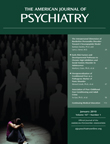Predicting Suicide Rates in the Elderly
To the Editor: In his editorial published in the August 2009 issue of the Journal, Yeates Conwell, M.D. (1), a distinguished geriatric psychiatrist and suicidologist, stated that since "the leading edge of the large post-World War II 'baby boom' cohort will reach the age of 65 in 2011, demographers predict a rapid rise in the number of seniors taking their own lives in subsequent decades" (1, p. 845). This is undoubtedly correct—a larger number of individuals would be predicted to produce a larger absolute number of total suicides, even if the rates were to remain constant. However, more alarming is the possibility that the completed suicide rates per 100,000 individuals in this cohort may rise when they become seniors, resulting in far more suicides in this enlarged population than predicted on the basis of size alone.
The post-World War II baby boom cohort is notable for likely accounting for, at least in part, the 300% rise in completed suicide rates in Caucasian men and African American men and women, as well as the 200% increase in Caucasian women, between 1950 and 1980. As this generation (born between 1945 and 1960) reached adolescence (between 1960 and 1975), their completed suicide rates began to rise, as documented by Holinger and Offer (2). As this population reached young adulthood, their rates became more similar to those of prior comparable age groups. However, this is the same cohort that has recently moved on to their "middle years" and may be at least partially responsible for the recent increase in the suicide rates among 45- to 60-year-old persons.
It is difficult to predict what the actual rate per 100,000 individuals will be as this population reaches older age, and some investigators have suggested that even decreased rates are possible (e.g., reference 3). Nonetheless, mental health professionals should be prepared for increased suicide rates and completed suicides, possibly well above the number that would be predicted on the basis of the large absolute size of this cohort alone.
1 : Suicide prevention in later life: a glass half full, or half empty? Am J Psychiatry 2009; 166:845–848 Link, Google Scholar
2 : Toward the prediction of violent death among the young, in Suicide in the Young. Edited by . Boston, John Wright Publishing, 1984, pp 15–29 Google Scholar
3 : Older adults, the next suicide epidemic? Suicide Life Threat Behav 1992; 22:322–332 Medline, Google Scholar



